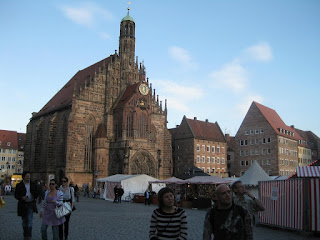
After we finished at the museum, we headed into Old Town to grab a bite to eat and look around. Ryan has a built in GPS whereas I take a bit longer to figure out where I am. We'd walked this same route during the Christmas market but it sure was more enjoyable without the crowds and stress of keeping tabs on all the kids. It seems there's a market in this square no matter what time of year!
After the museum I was starving so we were happy to stumble upon Vapianos where we like watching them whip up our pasta dishes and never, never skip the dessert! YUMMERS! We love their marscapone and strawberries as well as the tirumisu!!! Sharesies! I remembered to take a picture after we'd already dug in, too good to wait!
After that we walked up to the old fortress. Nurnberg was the unofficial capital of the Holy Roman Empire in medieval times. Nurnberg sits at a crossroads on one of the important trading routes between Italy and Northern Europe. It also housed the daily parliaments that were the administrative workings of the empire, called the Diets of Nuremberg. The fortress sits on a hill that overlooks the rest of the city with some great views.
On our way down, we stopped at St. Sebalds because it was so impressive. Visiting churches in Europe always provides a great way to learn about the history of the city or town. St. Sebalds had really pretty windows, but then our attention was drawn to the temporary placards hung on the columns showing how it had been destroyed during WWII and then rebuilt.
Now.
Before WWII, you can see it on the right.
After WWII.
Can you imagine that amount of destruction now having seen the before and after?! How horrible!
There was a brief chronicle of the church's destruction during the raids by a Hans Duerr for which I used Google's translate. Wikipedia confirmed what was said (again, sorry for my lack of in-depth research). Nurnberg was bombed by the British from 1943-1945, but particularly in February of '45 an hour's worth of bombing by both the British and Americans targeted and destroyed the historic medieval center of the city. In total, Duerr stated 5,366 people were killed in the two years of raids and 280,000 people were displaced.
Separate from that chronicle, the placards had sobering images of the church's destruction with a running poem translated into four languages. I was really touched by them, such as the following:
St. Sebald - A monument for peace
Peace - what is peace?
That we can go through the ruins
without fear of bombs?
That the sun warms people and stone
as if nothing had happened?
That the horror is already beginning
to belong to the past?
Burst are the bells,
melted down.
St. Sebald has no longer a voice.
Like so many people
whose words choked in their throat
in the summer of 45
as the horrifiec crimes of the Nazis
gradually became known.
Are wars also accounts?

20th April 1945 . . .
The guns are silent,
Nuremberg: fallen,
Laid down in the horror of a war
no-on had imagined would be like that . . .
Torn, broken through, empty
Sebald's towers reach towards heaven.
Fight for peace
17 December 1992:
100,000 citizens
carrying burning candles
form a circle around the heart of the city.
The seeds of voilence
must never germinate again
in our country!
This church is part of a reconciliation group here in Europe. German planes bombed the British town of Coventry destroying one of their historic churches. The reconciliation group celebrates the mutual rebuilding process. I must say I admire my German neighbors' resilience, hard work ethic, intelligence and also their kindness.
We really enjoyed this walk and as always, I wished I'd taken the time to research Nurnberg before we were there! However, being surprised is pretty fun too!










